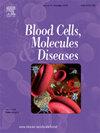镰状细胞病患者腿部溃疡发生的相关因素:一项病例对照研究
IF 1.7
4区 医学
Q3 HEMATOLOGY
引用次数: 0
摘要
目的探讨镰状细胞病患者腿部溃疡发生的相关因素。方法2019年8月至2020年4月在11个专科医院进行配对病例对照研究。方便样本包括262名18岁以上的诊断为镰状细胞病的人,190名对照和72名病例。为了评估与溃疡发生相关的可能因素,我们使用了单因素和多因素二元logistic回归模型。结果:与腿部溃疡发生相关的因素是先前愈合的溃疡(比值比48.48)、下肢水肿(比值比5.75)、最近6个月内使用抗生素(比值比3.08)、日常休息(比值比4.59)和使用压缩袜(比值比6.24)。超重(0.16)、体育休闲(0.33)和家庭活动(0.37)与较低的溃疡发生几率相关。结论确定镰状细胞病患者腿部溃疡发生可能性增加的因素增加了我们对该主题的认识,特别是通过确定减轻溃疡发生的因素和超出临床变量的因素。本文章由计算机程序翻译,如有差异,请以英文原文为准。
Factors associated with the occurrence of leg ulcers in people with sickle cell disease: A case-control study
Aim
To identify factors associated with the occurrence of leg ulcers in people with sickle cell disease.
Methods
Unpaired case-control study, conducted in 11 specialized services, between August 2019 and April 2020. The convenience sample consisted of 262 people over 18 years of age, diagnosed with sickle cell disease, with 190 controls and 72 cases. To evaluate the possible factors associated with the occurrence of ulcers, both univariate and multivariate binary logistic regression models were used.
Findings
The factors associated with the occurrence of leg ulcers were previously healed ulcers (odds ratio 48.48), presence of edema in the lower limbs (5.75), use of antibiotics in the last six months (3.08), daily rest (4.59), and use of compression stockings (6.24). Overweight (0.16), physical leisure (0.33), and domestic (0.37) activities were associated with a lower chance of occurrence of ulcers.
Conclusion
Identifying the factors that increase the likelihood of leg ulcers occurring in people with sickle cell disease adds to our knowledge of the subject, especially by determining factors that mitigate the occurrence of ulcers and that go beyond clinical variables.
求助全文
通过发布文献求助,成功后即可免费获取论文全文。
去求助
来源期刊
CiteScore
4.90
自引率
0.00%
发文量
42
审稿时长
14 days
期刊介绍:
Blood Cells, Molecules & Diseases emphasizes not only blood cells, but also covers the molecular basis of hematologic disease and studies of the diseases themselves. This is an invaluable resource to all those interested in the study of hematology, cell biology, immunology, and human genetics.

 求助内容:
求助内容: 应助结果提醒方式:
应助结果提醒方式:


